Classic Commentaries and Studies on Mark Upgrade (24 vols.)
Digital Logos Edition
Overview
The Classic Commentaries and Studies on Mark Upgrade provides students of Scripture with insightful resources that will help readers understand, study, and teach the Gospel of Mark. This collection combines practical and devotional literature on Mark, critical monographs, and commentaries, covering every aspect of the second Gospel and preparing readers for further study and competent instruction.
In the Logos editions, these valuable volumes are enhanced by amazing functionality and features. Scripture and ancient-text citations link directly to English translations and original-language texts, and important terms link to dictionaries, encyclopedias, and a wealth of other resources in your digital library. The Topic Guide lets you perform powerful searches to instantly gather relevant biblical texts and resources. Tablet and mobile apps let you take the discussion with you. With Logos Bible Software, the most efficient and comprehensive research tools are in one place, so you get the most out of your study.
Looking for more resources on Mark? Check out the original Classic Commentaries and Studies on Mark collection.

Key Features
- Combines expository, devotional, and critical commentaries
- Presents focused monographs on Markan priority and the Gospel’s historicity
- Helps Christian leaders teach the Gospel of Mark
Product Details
- Title: Classic Commentaries and Studies on Mark Upgrade
- Volumes: 24
- Pages: 5,454
Individual Titles
- Commentary on the Gospel of Mark by Franklin Weidner
- A Commentary on the Gospel of S. Mark by Harvey Goodwin
- An Exposition of the Gospel of Mark by William Kelly
- Commentary on the Gospel of Mark by W. N. Clarke
- Short Notes on the Greek Text of the Gospel of St. Mark by J. Hamblin Smith
- A Commentary on the Gospel according to Mark by William A. Campbell
- Studies in Mark’s Gospel by Charles S. Robinson
- Lessons on the Gospel of St. Mark by A. Irvine Robertson
- Spiritual Studies in St. Mark’s Gospel, vol. 1 by Arthur Ritchie
- Spiritual Studies in St. Mark’s Gospel, vol. 2 by Arthur Ritchie
- Spiritual Studies in St. Mark’s Gospel, vol. 3 by Arthur Ritchie
- First Gospel, Being The Gospel according to Mark: Translated and Arranged with a Critical Examination of the Book, Its Life of Jesus, and His Religion by Leicester Ambrose Sawyer
- The Gospel according to Mark with Introduction and Notes by J. J. Taylor
- Is Mark a Roman Gospel? by Benjamin Wisner Bacon
- The Gospel according to Mark and Its Meaning for Today by Ernest Trice Thompson
- St. Mark’s Gospel: The Text Divided into Paragraphs and Arranged Chronologically with Notes by J. Davies
- St. Mark’s Gospel with a Vocabulary by John T. White
- In the Footsteps of the Master: Sermon Outlines on St. Mark’s Gospel by J. H. B. Masterman
- Bible Thoughts for Daily Life: Family Readings from St. Mark’s Gospel by O. G. Campbell
- An Illustrated Commentary on the Gospels, vol. 2: Mark and Luke by Lyman Abbott
- Évangile selon Saint Marc by Marie-Joseph Lagrange
- Das Evangelium Marci übersetzt und erklärt by Julius Wellhausen
- Das Markusevangelium nach seinem Quellenwerthe für die evangelische Geschichte by August Klostermann
- Die Geschichtlichkeit des Markusevangelium by Bernard Weiss
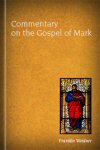
Using the King James Version and the Revised Version as his text, Franklin Weidner’s Commentary on the Gospel of Mark provides a comprehensive examination of Mark from a Lutheran perspective. Written for the secondary classroom and home Bible education, Weidner’s work makes the Gospel of Mark clear—it explains facts, resolves difficult passages, and highlights parallel passages in other Synoptic Gospels. Though Weidner’s scholarly expertise lies elsewhere, this commentary was thoughtfully edited and reviewed by leading Lutheran Bible scholar Dr. Adolph Spaeth of Evangelical Lutheran Seminary, Philadelphia. The book is full of helpful study questions. This commentary includes the long ending of Mark, 16:9–20.
Franklin Weidner (1851–1915) was professor of English and history at Muhlenberg College. He was educated at Lutheran Theological Seminary in Philadelphia, and was ordained in 1873. In 1887, he received his doctorate of divinity from Carthage College in Illinois. He went on to pastor Phillipsburg Lutheran Church in, Phillipsburg, Pennsylvania from, 1873 to 1878. He was director of the Lutheran Theological Seminary in Philadelphia, and frequently served as delegate on the General Council of the Evangelical Lutheran Church. He was a member of the American Philological Association, the Society of Biblical Literature, and the American Oriental Society. He also served as professor of systematic theology and exegesis at Augustana Swedish-English Theological Seminary, Augsburg, Germany.
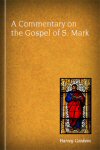
Writing with the firm belief that the intricate details of the Greek biblical text can be understood by anyone whose first language is English, Harvey Goodwin’s A Commentary on the Gospel of S. Mark simplifies the technical issues in Mark’s Gospel and presents them for a popular audience. Goodwin examines the text verse by verse, highlighting the unique aspects of Mark not found in other Gospels, and examines the text verse by verse. This commentary includes the long ending of Mark, 16:9–20.
Harvey Goodwin (1818–1891) was an Anglican deacon, locum of St. Giles, minister at St. Edwards’ Church, Cambridge, and bishop of Carlisle. He was educated at Cambridge, and wrote multiple books, including Parish Sermons, Essays on the Pentateuch, The Foundations of the Creed, and A Commentary on the Gospel of St. Luke.
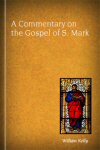
One of the most prolific commentators of his generation, William Kelly wrote commentaries that excel in thoroughness and insight. In An Exposition of the Gospel of Mark, Kelly unpacks Mark’s Gospel, explaining difficult passages, and focusing on issues pertinent to everyday life.
William Kelly (1826–1906) was educated at Trinity College, Dublin. He was a prominent member of the Plymouth Brethren, and a very prolific writer. His work enjoyed high esteem among churchmen and scholars, and included Lectures on the Epistle of Paul the Apostle to the Colossians, Lectures on the Epistle of Paul, the Apostle, to the Ephesians, With a New Translation, Lectures on the Epistle of Paul the Apostle to the Galatians, and Lectures on the Book of Revelation.
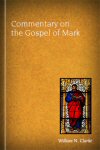
Aiming to provide a “plain, straightforward, practical exposition of reverent common sense,” W. N. Clarke’s Commentary on the Gospel of Mark emphasizes practical application and clear understanding of the text’s meaning. Clarke, a minister, was familiar with the technical issues raised by Mark’s text and highlights them appropriately, but his goal was to provide a commentary that edifies the life of the church. This commentary includes the long ending of Mark, 16.9–20.
W. N. Clarke (b. 1841) was professor of New Testament and interpretation at McMaster Hall, Toronto. He was educated at Colgate University and Hamilton Theological Seminary. He pastored churches in Keene, New Hampshire, Newton Centre, Massachusetts, Montreal, and Hamilton, New York. He wrote several books including What Shall We Think of Christianity?, Can I Believe in God the Father?, and An Outline of Christian Theology.
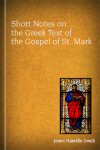
Using the Westcott-Hort Greek New Testament, Classical scholar J. Hamblin Smith presents a reader’s vocabulary guide and commentary on the Greek text of Mark. Noting divergences between Westcott-Hort and the Authorized Version and the Revised Version, this book was originally intended to help Cambridge University students prepare for graduate examinations. Modern readers will find it useful as a handbook that clarifies Mark’s unique vocabulary, and highlights the vocabulary it shares with other New Testament books.
J. Hamblin Smith (1829–1901) was a mathematician, theologian, linguist, and classics scholar. He was educated at Cambridge, and was lecturer in classics at Peterhouse, Cambridge, from 1868 to 1872. He spent most of his career as a private tutor in various subjects, and authored many books, including Rudiments of English Grammar, An Introduction to the Study of Geometrical Conic Sections, Elementary Trigonometry, Riders In Euclid: Containing a Graduated Collection of Easy Deductions, Exercises on the Elementary Principals of Latin Prose Composition, and Short Notes on the Greek Text of the Acts of the Apostles.
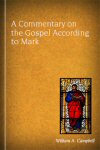
A Commentary on the Gospel according to Mark
- Author: William A. Campbell
- Publisher: Presbyterian Publishing Company
- Publication Date: 1881
- Pages: 348
A life-long Presbyterian missionary, William Campbell excelled in explaining Mark’s stories and theological concepts to readers who are unfamiliar with Bible study. Throughout his career, Campbell emphasized the need for local-church leaders to teach the gospel to their own people. Clear explanations and accessible prose will help foreign leaders to instruct their own people with skill and clarity.
William A. Campbell (1841–1921) was a Presbyterian missionary in Taiwan, and a linguist. He served in Taiwan for nearly 50 years, and while in residence began the island’s first school for blind children. He studied Taiwan’s history and culture extensively, and was described as “without doubt the greatest authority on [Taiwan] living.” He ardently believed in training local clergy for service in their own culture, and was likely the first person of European descent to see Sun-Moon Lake. His work coincided with that of other prominent missionaries to Taiwan, including Thomas Barclay, James Maxwell, and George Leslie Mackay. He authored many books including Past and Future of Formosa: With a New Map of the Island, Memorandum on Printing Missionary Books in the So-Called South Formosa Dialect, and The Gospel of St. Matthew in Formosan (Sinkang Dialect).
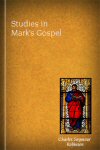
Originating “in the regular utterances of the pulpit duty from Sabbath to Sabbath,” these studies “follow the gospel history and doctrine in orderly progress through the narrative of the evangelist Mark.” Pericope by pericope, Charles Robinson’s work unfolds the dramatic and moving story of Jesus’ life and death in order to make the meaning of the text plain, by highlighting literary features, doctrine, and the drama of the gospel story.
Charles S. Robinson was pastor of Memorial Presbyterian Church, New York City. He was educated at Williams College, Princeton Theological Seminary, and Union Theological Seminary. He was the editor of Illustrated Christian Weekly, and served as a pastor in multiple Presbyterian churches, including the American Chapel of Paris from 1868–1871. A scholar of Christian hymns, he authored or compiled several hymn-books, such as Songs of the Church, Songs for the Sanctuary, and Spiritual Songs.
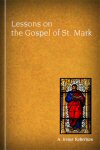
With its “plain and pointed” style this commentary is accessible to anyone who desires to learn more about the Gospel of Mark. Methodical but clear, it examines the text of Mark for the purpose of aiding teachers and their students, while also providing a sense of urgency and expectancy for the rewards of studying Scripture. The commentary unpacks the text pericope by pericope, and provides bold topic headings such as “Jesus at Prayer” and “The Bitterness of the Pharisees” for easy reference.
A. Irvine Robertson (1847–1925) received his doctorate of divinity from St. Andrews University. He was a Presbyterian minister, serving in several churches, including West Church, Aberdeen, and Clackmannan, Scotland.
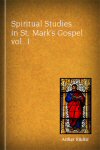
Volume one of Arthur Ritchie’s Spiritual Studies in St. Mark’s Gospel examines select passages from the first four chapters of the New Testament’s second book. Confining its study to spiritual themes—as opposed to historical or linguistic questions—Richie’s study is useful for the edification of Christians who are trying to explore the role of spirituality in their everyday life.
Arthur Ritchie (1884–1914) was reverend at St. Ignatius of Antioch Episcopal Church, New York City.
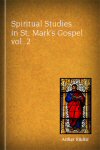
Spiritual Studies in St. Mark’s Gospel, vol. 2
- Author: Arthur Ritchie
- Publisher: Young Churchman Co.
- Publication Date: 1917
- Pages: 300
Volume two of Arthur Ritchie’s Spiritual Studies in St. Mark’s Gospel examines select passages from chapters 5–11. Confining its study to spiritual themes—as opposed to historical or linguistic questions—Richie’s study is useful for the edification of Christians who are trying to explore the role of spirituality in their everyday life.
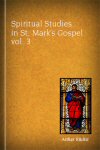
Volume three of Arthur Ritchie’s Spiritual Studies in St. Mark’s Gospel examines select passages from Mark 12–16. Confining its study to spiritual themes—as opposed to historical or linguistic questions—Richie’s study is useful for the edification of Christians who are trying to explore the role of spirituality in their everyday life.
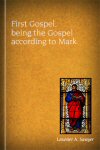
Firmly asserting Markan priority on literary grounds, and rejecting an early understanding of the document known as “Q,” Leicester Sawyer’s commentary is an early but significant critical commentary on Mark. He provides a full original English translation of Mark’s Greek text with text critical notes, and provides a full catalogue of the “kernel passages” in Mark which both Matthew and Luke are believed to have borrowed. Sawyer also examines other critical issues, such as Peter’s role in the authorship, the “Roman” character of the Gospel, and a full litany of other historical, cultural, and religious items.
Leicester Ambrose Sawyer (1807–1898) studied theology at Princeton and was ordained in the Presbyterian ministry in 1832, but later joined the Congregational Church, and then the Unitarian. He was the author of numerous works, including Organic Christianity, A Dissertation on Servitude, Critical Exposition of Baptism, Daniel: With Its Apocryphal Additions, and The New Testament Translated from the Greek.
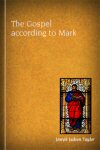
This commentary is intended for readers who are only familiar with the English text. J. J. Taylor, whose energetic appreciation of, and deep love for, the Bible show in every word, presents an expository commentary that covers historical, authorial, and culture issues while unpacking the text verse by verse. The biblical text runs across the top section of each page, with the commentary in the bottom section, making for easy reference. This commentary includes the long ending of Mark, 16:9–20.
J. J. Taylor (1855–1930) was minister of First Baptist Church, Savannah, Georgia, and president of Georgetown College, Georgetown, Kentucky. He was named after the famous missionary Adonirom Judson, and was an anti-evolutionist and avowed pacifist. During WWI, his views on war caused bitter division and controversy in the Southern Baptist Convention, and he accused the denomination of having "too much of Caesar and too little of Christ" in its attitude toward the war. He wrote many books, including God of War, The Evolution Theory: Plain Words for Plain Folks, and My Lord Christ: A Tribute, Radiant Hopefulness, and contributed to the book Chinese Missions.
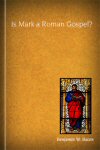
This monograph on the Gospel of Mark examines the historical context of Mark for the purpose of illuminating its internal cultural assumptions in order to better understand its intended audience. To this send, Benjamin Bacon examines Mark’s prolific use of editorial glosses, the books geographical perspective, the character of its theological teaching, and the possible role of “Roman ritual” in the Gospel.
Benjamin Wisner Bacon (1860–1932) was born in Litchfield, Connecticut and educated at Yale. He was served as an instructor at Yale Divinity School in New Testament Greek and as professor of New Testament criticism and exegesis. His numerous works include The Beginnings of Gospel Story: A Historical-Critical Inquiry into the Sources and Structure of the Gospel According to Mark, Commentary on the Epistle of Paul to the Galatians, and The Triple Tradition of the Exodus: A Study of the Structure of the Later Pentateuchal Books, Reproducing the Sources of the Narrative, and Further Illustrating the Presence of Bibles within the Bible.
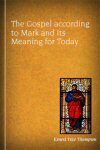
The commentary is intended to augment and supplement lay Bible study. Dividing the text into paragraphs, Ernest Thompson unpacks the text in clear language, emphasizing both the meaning of the text and its practical application. He places special focus on the last week of Jesus’ ministry. This commentary includes the long ending of Mark, 16:9–20.
Ernest Trice Thompson (c. 1895–1985) was president of the Presbyterian Church in the United States (PCUS), and led the way to its reunification with the Presbyterian Church in the United States of America (PCUSA) in 1983. The two denominations split during the Civil War over a divide between traditional Calvinism and progressive Reformed doctrines. Thompson was the editor of The Presbyterian Outlook, and author of several books, including Presbyterian Missions in the Southern United States, Presbyterians in the South (3 vols.), Jesus and Citizenship, and Changing Emphases in American Preaching. He also served as professor at Union Theological Seminary in Virginia for 42 years.
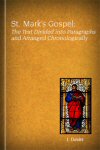
Succinct but thoroughly informative, this commentary functions more like a handbook to the Gospel, giving priority to the chronology of events. Each passage of Scripture is presented as an individual paragraphs followed by brief notes. This commentary includes the long ending of Mark, 16:9–20.
J. Davies was a professor at the University of London. His other works include St. Matthew’s Gospel: The Text Divided into Paragraphs, and Arranged Chronologically, with Notes, Notes on Judges (including Ruth), and Notes on 2 Kings.
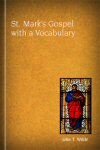
It is common for modern second-year Greek students to be assigned the translation of 1 John. Likewise, in the nineteenth century, grammar students were often required to systematically work their way through the New Testament Gospels. John White produced St. Mark’s Gospel with a Vocabulary so that students could isolate the Greek text while leaning on a “reader’s” dictionary for more difficult terms and less frequently used syntactical and grammatical forms. The Greek text includes the long ending of Mark, 16:9–20.
John T. White (1856–1924) was a New Testament and Greek scholar.
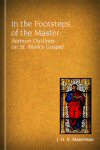
Mastery of sermon preparation requires repetition and dedication. In the Footsteps of the Master provides expository outlines of Mark’s Gospel that will aid teachers and ministers in organizing their sermons. J. H. B. Masterman pays attention to select individual passages, each in succinct fashion. This commentary includes the long ending of Mark, 16.9–20.
J. H. B. Masterman (1867–1953) was canon of Coventry, and Anglican bishop of Plymouth. He was educated at St. John’s College, Cambridge, and was a distinguished scholar. He served as vicar at St. Aubyn’s Church, Devonport, and St. Mary-le-Bow, London. He wrote several books, including The Story of the English Towns: Birmingham, The Christianity of Tomorrow , and Studies in the Book of Revelation.
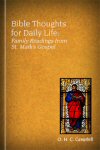
Written by a beloved teacher of the Scriptures, this volume intends to augment the teaching of Scripture in the family home. Consciously avoiding critical issues, Campbell seeks to provide practical teaching that will further draw readers into study of the Bible. This commentary includes the long ending of Mark, 16:9–20.
O. H. Campbell wrote many books on the Bible, including The Gospel of Suffering, My Home, and Daily Prayers for Busy Homes.
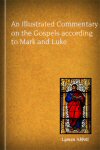
Hoping to aid all types of Christian teachers, his commentary seeks “to give the results rather than the processes of scholarship.” It is based on the Greek text of the New Testament, but provides full translations. It takes advantage of all facets of scholarship, including historical analysis and exegesis, and archaeology. Helpful illustrations, maps, and other images augment the commentary, and the main focus—at all points—is to illuminate the meaning of Mark’s Gospel. This commentary includes the long ending of Mark, 16:9–20.
Lyman Abbott is the author of The Acts of the Apostles with Notes, Comments, Maps, and Illustrations, Dictionary of Religious Knowledge, and Jesus of Nazareth.
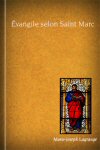
Évangile selon Saint Marc
- Author: Marie-Joseph Lagrange
- Publisher: Gasbalda
- Publication Date: 1911
- Pages: 455
This commentary on the Gospel of Mark seeks to illuminate the meaning of the text through exegetical examination. Comprehensive in scope, it highlights the major critical issues with the text while explaining its meaning clearly.
Marie-Joseph Lagrange (1855–1938) was a Catholic priest of the Dominican Order, and founder of the École Biblique in Jerusalem. A polymath, Lagrange pursued study in many areas, but his primary focus was the study of Scripture, especially text criticism. He was also passionate about teaching Catholic laity to study Scripture on their own. He was the subject of Bernard Montagnes’ biography The Story of Father Marie-Joseph Lagrange: Founder of Modern Catholic Bible Study. This commentary is written in French.
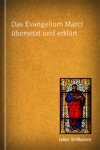
Written by one of the most famous representatives of German Higher Criticism, this critical text examines the literary structure and linguistic character of the Gospel of Mark in precise detail. The commentary also focuses on redaction criticism, a form of study examining the shared passages of the Synoptic Gospels.
Julius Wellhausen (1844–1918) was privatdozent of Old Testament at Göttingen, professor of philology at Halle, and professor ordinarius at Greifswald and Marburg. He is widely known for his controversial theories on the origins of the Pentateuch, now called the “documentary hypothesis.” This theory, which principally addressed the compiling and date of authorship of the Pentateuch, formed the basis of his book Prolegomena to the History of Israel. In 1882, struggling with his conscience, he resigned his professorship stating, “I became a theologian because the scientific treatment of the Bible interested me; only gradually did I come to understand that a professor of theology also has the practical task of preparing the students for service in the Protestant Church, and that I am not adequate to this . . . I make my hearers unfit for their office. Since then my theological professorship has been weighing heavily on my conscience.” This commentary is written in German.
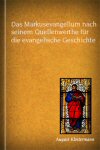
Based on the Greek text, this commentary provides a comprehensive examination of the Gospel of Mark, with a particular emphasis on its value for Christian origins. This commentary is written in German, and covers the long ending of Mark—16:9–20.
August Klostermann (1837–1915) was a German Lutheran theologian. He studied at Erlangen and Berlin, and was a privatdozent at Göttingen (1864–1868), and then a professor of Old Testament exegesis at Kiel. He also served as a pastor in Bückeburg. He authored several books, including Der Pentateuch, Ueber Deutsche Art bei Martin Luther.
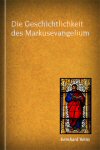
Die Geschichtlichkeit des Markusevangelium
- Author: Bernard Weiss
- Publisher: E. Runge
- Publication Date: 1905
- Pages: 67
The historical contributions of the Gospels have been widely debated for centuries. This book, written in German, examines the historicity of the Gospel of Mark and how modern historiography should approach questions about this biblical book.
Bernard Weiss (1827–1918) was professor, theologian, and textual critic. He wrote several books and commentaries including Early Christianity, The Gospel and the Gospels, and The Religion of the New Testament.
Reviews
0 ratings